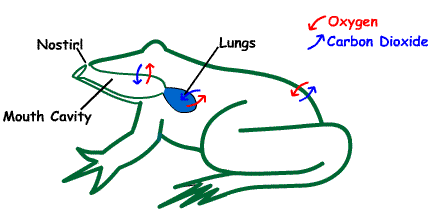
The frog has three respiratory surfaces on its body that it uses to exchange gas with the surroundings: the skin, in the lungs and on the lining of the mouth.

While completely submerged all of the frog's repiration takes place through the skin. The skin is composed of thin membranous tissue that is quite permeable to water and contains a large network of blood vessels. The thin membranous skin is allows the respiratory gases to readily diffuse directly down their gradients between the blood vessels and the surroundings. When the frog is out of the water, mucus glands in the skin keep the frog moist, which helps absorb dissolved oxygen from the air.
A frog may also breathe much like a human, by taking air in through their nostrils and down into their lungs. The mechanism of taking air into the lungs is however sligthly different than in humans. Frogs do not have ribs nor a diaphragm, which in humans helps serve in expand the chest and thereby decreasing the pressure in the lungs allowing outside air to flow in.
In order to draw air into its mouth the frog lowers the floor of its mouth, which causes the throat to expand. Then the nostrils open allowing air to enter the enlarged mouth. The nostrils then close and the air in the mouth is forced into the lungs by contraction of the floor of the mouth. To elimate the carbon dioxide in the lungs the floor of the mouth moves down, drawing the air out of the lungs and into the mouth. Finally the nostrils are opened and the floor of the mouth moved up pushing the air out of the nostrils.
Frogs also have a respiratory surface on the lining of their mouth on which gas exchange takes place readily. While at rest, this process is their predominate form of breathing, only fills the lungs occasionally. This is because the lungs, which only adults have, are poorly developed.
To see a little animated demonstration of the physiology of frog ventilation
visit:
http://www.tvdsb.on.ca/westmin/science/snc2g1/frogresp.htm
Refrences:
http://www.tvdsb.on.ca/westmin/science/snc2g1/frogresp.htm
http://www.marymount.k12.ny.us/marynet/stwbwk02/frog/html/respirf.htm
http://www.frogs.org/library/item.asp?InfoResourceID=70&ReferringPage=/froghoo/category.asp?CategoryID=1